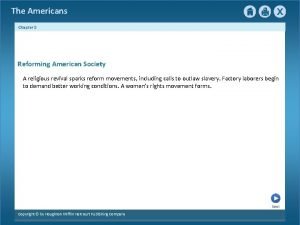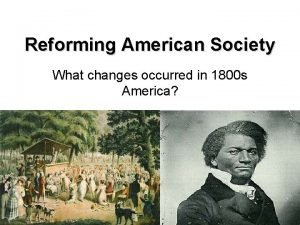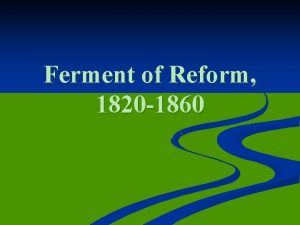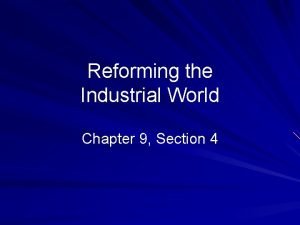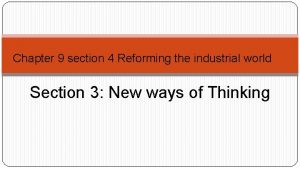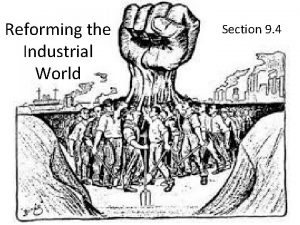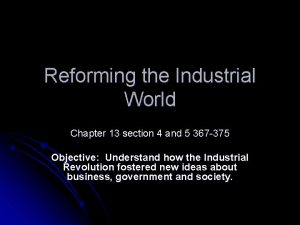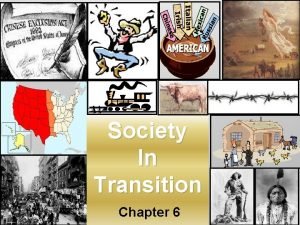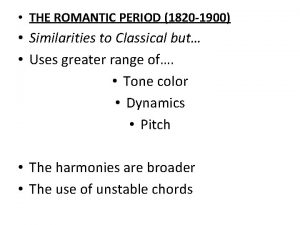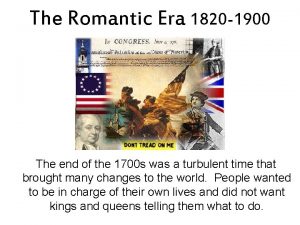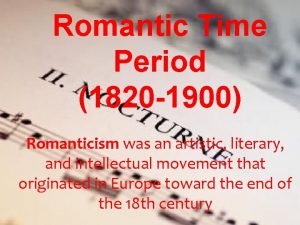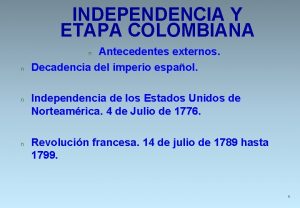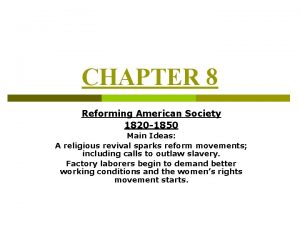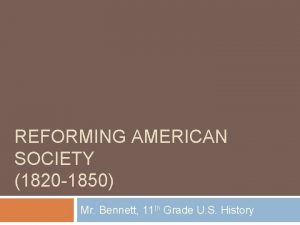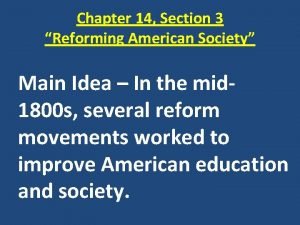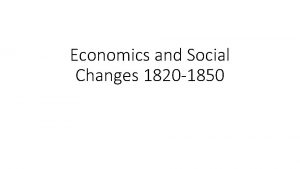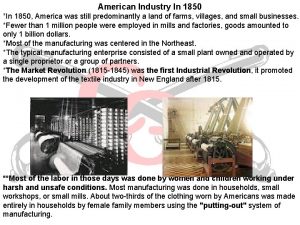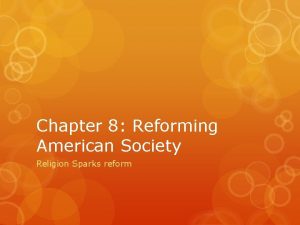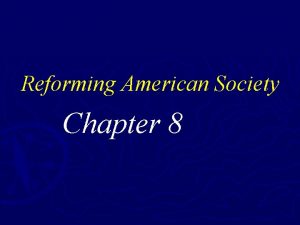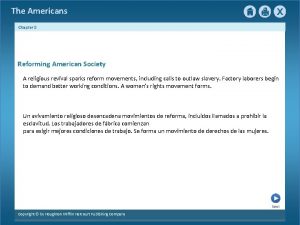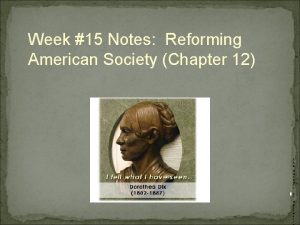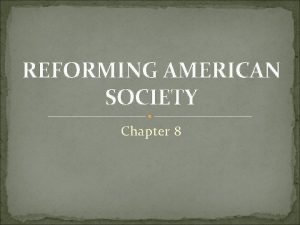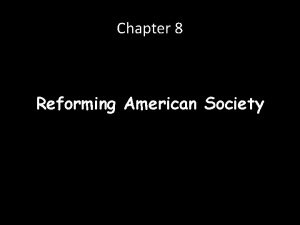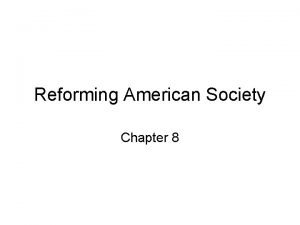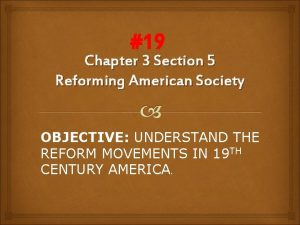CHAPTER 8 Reforming American Society 1820 1850 Main

















- Slides: 17

CHAPTER 8 Reforming American Society 1820 -1850 Main Ideas: A religious revival sparks reform movements; including calls to outlaw slavery. Factory laborers begin to demand better working conditions and the women’s rights movement starts.

During the 1830 s reforms of all sorts spread over the U. S. -evangelism, women’s rights, school reform, and abolition. p All of these were in response to changes in industrial growth, migration and immigration, and communication. p

Section 1 Religion Sparks Reform p A renewal of religious sentiment-known as the Second Great Awakening-inspired a host of reform movements.

Religious Activism p Second Great Awakeningn p p Individual responsibility for seeking salvation, self -improvement, and society. Preacher Charles Grandison Finney inspired “emotional” religious faith. Church services were large gatherings of people; some of more than 20, 000 Large gatherings, called revivals, lasted for several days and spread new ideas about religion. Revivalism greatly increased church membership.

Charles Grandison Finney In the midst of shifts in theology and church polity, American Christians took it upon themselves to reform society during this period. Known commonly as antebellum reform, this phenomenon includes reforms in temperance, women's rights, abolitionism, and a multitude of other questions and problems faced by society. Historians stress the understanding common among participants of reform as being a part of God's plan. As a result, individual Christians contemplated their roles in society in purifying the world through the individuals to whom they could bring salvation. Interest in transforming the world eventually became reapplied to mainstream political action, as temperance activists, antislavery advocates, and proponents of other variations of reform would seek to implement their beliefs into national politics. While religion had previously played an important role on the American political scene, the Second Great Awakening would highlight the important role which individual beliefs would play, doing much to illuminate issues of faith through present day.

Schools Undergo Reform p p p In the early 1800 s, school attendance was not compulsory and was not divided based on grade level. During this time the first tax-supported public schools were formed. Horace Mann established teacher training courses and curriculum reform. He wanted both men and women to have access to public education and believed that education was essential to the success of democracy. He helped create the state Board of Education in Massachusetts, the first ever in the US. This inspired other states to make reforms in education as well.

Horace Mann

Section 2 Slavery and Abolition In the 1830 s, the abolitionist movement gained momentum. p Some wanted to limit slavery’s expansion into new territories, while others were determined to end slavery completely. p White members of this movement were mostly middle class, educated, church people from New England. p Black members were mostly former slaves. p

p p William Lloyd Garrison-radical white abolitionist that founded the New England Anti-Slavery Society and the American Anti-Slavery Society. In his newspaper, The Liberator, he called for immediate emancipationfreeing of slaves.

p David Walker-freed Afr. Amer. , encouraged blacks to fight for freedom instead of waiting to get it. Cover of David Walker's Appeal to the Colored Citizens of the World

p p p Frederick Douglassformer slave, taught to read and write by former owner’s wife. After escaping and travelling North to New York, Douglass became a lecturer for Garrison’s Anti. Slavery Society. He published the newspaper, The North Star, which encouraged abolition through political action.

Nat Turner-former slave and preacher, led a slave rebellion where about 60 whites were killed. p Turner and his followers were captured, but 200 slaves were killed in retaliation. p Southern states created slave codes to tighten limits on blacks. p Free Afr. Amer. and slaves lost rights. p

Section 3 Women and Reform p p p Women reformers expanded their efforts from movements such as abolition and temperance to include women’s rights. Elizabeth Cady Stanton and Lucretia Mott formed a women’s rights society. Many middle-class, white women were inspired by religion and joined various reform movements. Sarah and Angelina Grimke were sisters from South Carolina who worked for abolition. Some men supported women reformers, but most rejected them.

Elizabeth Cady Stanton and Susan B. Anthony Lucretia Mott Sarah and Angelina Grimke

Many women join in the temperance movement-prohibiting alcohol. p The American Temperance Society was founded in 1826 and had 6000 local groups by 1833. p

In 1848, Stanton and Mott held the Seneca Falls Convention for women’s rights. p They wrote a “Declaration of Sentiments” modeled after the Declaration of Independence. p Attendees agreed that men and women were equal, women should participate in public issues, and women should have suffrage rights; the right to vote. p

p p Former slave, Sojourner Truth (formerly Isabella Baumfree) travelled the country preaching and teaching about slavery. She argued for abolition and women’s rights.
 Chapter 8 reforming american society
Chapter 8 reforming american society Reforming american society
Reforming american society Second great awakening
Second great awakening Chapter 9 section 4 reforming the industrial world
Chapter 9 section 4 reforming the industrial world Chapter 25 section 4 reforming the industrial world
Chapter 25 section 4 reforming the industrial world Chapter 9 section 4 reforming the industrial world
Chapter 9 section 4 reforming the industrial world Chapter 9 section 4 reforming the industrial world
Chapter 9 section 4 reforming the industrial world Chapter 9 section 4 reforming the industrial world
Chapter 9 section 4 reforming the industrial world Chapter 6 american society in transition
Chapter 6 american society in transition Characteristics of the romantic period
Characteristics of the romantic period 1820 hairstyles
1820 hairstyles Jacob pertl
Jacob pertl Revolucion liberal de 1820
Revolucion liberal de 1820 1820-1900
1820-1900 1820 to 1910
1820 to 1910 1750s music
1750s music Antecedentes externos de la independencia de colombia
Antecedentes externos de la independencia de colombia Revolucion liberal de 1820
Revolucion liberal de 1820
